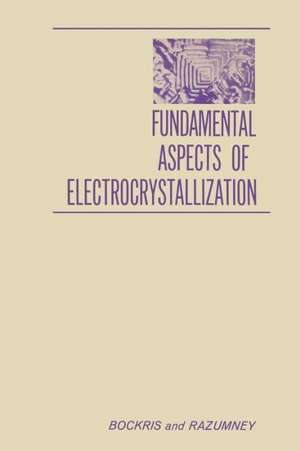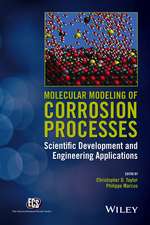Fundamental Aspects of ELECTROCRYSTALLIZATION
Autor John O M. Bockrisen Limba Engleză Paperback – 12 feb 2012
Preț: 380.25 lei
Nou
Puncte Express: 570
Preț estimativ în valută:
72.77€ • 75.69$ • 60.08£
72.77€ • 75.69$ • 60.08£
Carte tipărită la comandă
Livrare economică 15-29 aprilie
Preluare comenzi: 021 569.72.76
Specificații
ISBN-13: 9781468406993
ISBN-10: 146840699X
Pagini: 168
Ilustrații: XII, 156 p.
Dimensiuni: 152 x 229 x 9 mm
Greutate: 0.23 kg
Ediția:Softcover reprint of the original 1st ed. 1967
Editura: Springer Us
Colecția Springer
Locul publicării:New York, NY, United States
ISBN-10: 146840699X
Pagini: 168
Ilustrații: XII, 156 p.
Dimensiuni: 152 x 229 x 9 mm
Greutate: 0.23 kg
Ediția:Softcover reprint of the original 1st ed. 1967
Editura: Springer Us
Colecția Springer
Locul publicării:New York, NY, United States
Public țintă
ResearchCuprins
1 Retrospect.- 1. The First Contributions.- 2. Earlier Concepts.- 2 Perspective.- 3 Methods of Investigation.- 1. Electrochemical Methods.- 2. Optical Methods.- 3. Surface and Solution Preparation.- 4 Basic Models of the Atomic Movements Which Lead to Deposition.- 1. A Definition.- 2. Mechanism of Interfacial Charge Transfer.- 3. The Alternative Paths for Metal Deposition.- 4. What Happens to the Hydration Sheath During the Atomic Movements Between Arrival in the Double Layer and Building into the Lattice?.- 5. Is Charge Transfer to all Types of Sites on the Metal Surface Equally Probable?.- 6. Can “Two-Electron Transfers” Take Place?.- 7. Adatom or Adion?.- 8. Path and Rate-Determining Step in Deposition: Theoretical Indications.- 5 Transients.- 1. Origin of Transient Measurements in Metal Deposition Studies.- 2. The Mehl and Bockris Analysis.- 3. Better Approximations in the Analysis of Transients.- 6 Discussion of Some Basic Questions Concerning Path and Rate-Determining Step.- 1. The Charge-Transfer Step.- 2. The Two Paths: Via the Surface or Directly to Kink Sites.- 3. The Generality of Rate Control by the Charge-Transfer Step at High Current Densities.- 4. Under Surface-Diffusion Control, Deposition Does Take Place Preferentially Near a Growth Site.- 7 Deposition and Dissolution Kinetics as a Function of the Initial Substrate.- 1. Variation of the Activity of a Surface with Time.- 2. The Effect of the Potential Dependence of the Activity of the Emergent Dislocations on the Kinetics of Deposition.- 3. The Effect of Change of Concentration of Emergent Dislocations in the Initial Substrate.- 8 Why Do Some Crystals Grow in Filamentary Shapes?.- 1. Crystal Growth, Dendritic Growth, and the Study of the Mechanism of Electrocrystallization.- 2. Facts about DendriticGrowth on Electrodes.- 3. Mechanism of Dendritic Growth.- 9 Mechanistic Aspects of Morphology.- 1. Preliminary Observations.- 2. Some Forms Observed.- 3. The Potential Dependence of the Growth Form.- 4. Impurity Effects on Morphology.- 5. Texture.- 10 Kinematics of Step Propagation.- 1. A Necessary Methodology.- 2. Microsteps.- 3. Macrosteps.- 4. Facts of Macrostep Movements.- 5. Determination of the Origin of Microsteps.- 6. The Instability of Bunches of Microsteps in the Absence of Impurities.- 7. Impurity Adsorption Theory of Bunching.- 8. Mechanism of the Propagation and Fading of Macrosteps.- 11 Effect of Adsorbed Substances upon Electrocrystallization.- 1. Facts.- 2. Adsorption of Inhibitors at Electrified Interfaces.- 3. Thermodynamics and Kinetics of Adsorption.- 4. Mechanisms of Inhibition.- 12 The Theory of the Electrochemical Leveling and Brightening of Surfaces.- 1. Factors Affecting Current Distribution.- 2. Leveling.- 3. Bright Electrocrystallization.- 13 Electrocrystallization and Crystallization from the Gas Phase.- 14 Prospects.- References.




